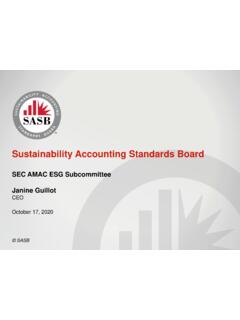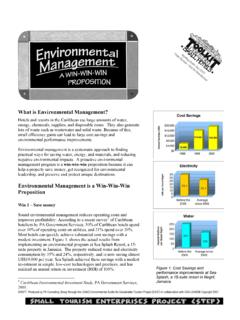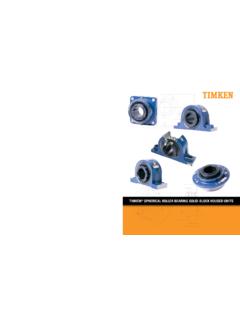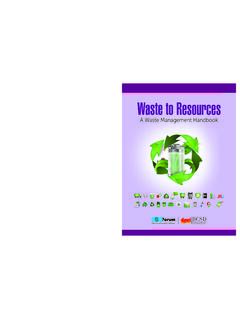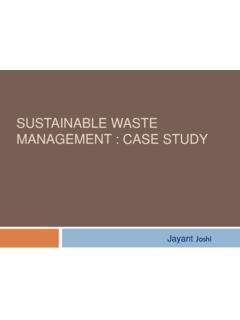Transcription of Solid Waste Management in Nepal - Asian Development Bank
1 Solid Waste Management in Nepal Current Status and Policy RecommendationsSolid Waste Management in NepalCurrent Status and Policy RecommendationsPrinted on recycled paper 2013 Asian Development BankAll rights reserved. Published in the 978-92-9254-232-0 (Print), 978-92-9254-233-7 (PDF)Publication Stock No. RPT135798 Cataloging-in-Publication DataAsian Development Bank. Solid Waste Management in Nepal : Current status and policy City, Philippines: Asian Development Bank, Solid Waste Management . 2. Urban. I. Asian Development views expressed in this publication are those of the authors and do not necessarily reflect the views and policies of the Asian Development Bank (ADB) or its Board of Governors or the governments they represent.
2 ADB does not guarantee the accuracy of the data included in this publication and accepts no responsibility for any consequence of their making any designation of or reference to a particular territory or geographic area, or by using the term country in this document, ADB does not intend to make any judgments as to the legal or other status of any territory or encourages printing or copying information exclusively for personal and noncommercial use with proper acknowledgment of ADB. Users are restricted from reselling, redistributing, or creating derivative works for commercial purposes without the express, written consent of Development Bank6 ADB Avenue, Mandaluyong City1550 Metro Manila, PhilippinesTel +63 2 632 4444 Fax +63 2 636 orders, please contact.
3 Department of External RelationsFax +63 2 636 of Tables and Figures vForeword viAcknowledgments viiCurrency Equivalents viiiAbbreviations viiiWeights and Measures viiiGlossary ixExecutive Summary xI. Introduction 1A. Background 1B. Geographical Distribution of Municipalities 2C.
4 Land Use Pattern 3D. Urban Rural Setting 3E. Demographic Information 4F. Objectives of the Study 5G. Scope of the Study 5H. Study Limitations 6II. Municipal Solid Waste Generation and Composition 7A. Household Waste Generation 7B. Institutional and Commercial Waste Generation 8C. Municipal Solid Waste Generation 9D. Municipal Solid Waste Composition 9 III. Existing Solid Waste Management System 13A. Collection and Segregation 13B. Transport and Final Disposal 14C. Resource Recovery Methods 16D.
5 Public Awareness and Community Mobilization 17E. Special Waste Management 17IV. Managerial Aspects of Solid Waste Management 19A. Organizational Structure 19B. Resources Allocation for Waste Management 19C. Solid Waste Management Planning 20D. Actors Involved in Solid Waste Management 20E. Solid Waste Management Policy and Legislation 21V. Nepal s Solid Waste Management Status in the Region 22A. Solid Waste Generation 22B. Waste Composition 23C. Waste Management Practices 24iv ContentsVI.
6 Key Policy Challenges and Recommendations 25A. Development of Policy, Strategy, and Guidelines 25B. Promotion of Reduce, Reuse, and Recycle 25C. Strengthening Capacity of Local Bodies 25D. Public Participation and Consultation 26E. Cost Recovery 26F. Improvements toward Integrated Solid Waste Management 26G. Public Private Partnership 27H. Data Management , Updating, and Dissemination 28 VII. Conclusions 29 Appendixes 1 Main Outputs of the Technical Assistance 30 2 Area and Population of the 58 Municipalities of Nepal 31 3 Methodology for Sampling and Field Work 33 4 Municipal Solid Waste Generation and Collection Efficiency in the 58 Municipalities 37 5 Composition of Household Waste in the 58 Municipalities (%) 40 6 Composition of Institutional Waste in the 58 Municipalities (%)
7 42 7 Composition of Commercial Waste in the 58 Municipalities (%) 44 8 Solid Waste Management Systems in Municipalities 46 9 Total Municipal Budget and Solid Waste Management Budget in the 58 Municipalities, Fiscal Years 2010 2012 53vTables and FiguresTables1 Geographical Distribution of the 58 Municipalities 42 Classification of Municipalities Based on Population 53 Per Capita Waste Generation of Selected Countries in Asia 224 Waste Composition of Municipal Solid Waste in Nepal and Other Selected Countries 23 Figures1 Location of the 58 Municipalities 32 Average Household Waste Generation by Monthly Expenditure Level 73 Average Household Waste Generation Pattern in Different Ecological Regions 84 Composition of Household Waste in the 58 Municipalities 105
8 Composition of Household Wastes in Different Ecological Regions 116 Average Composition of Institutional Waste in the 58 Municipalities 117 Average Composition of Commercial Waste in the 58 Municipalities of Nepal 128 Types of Solid Waste Disposal Method in the 58 Municipalities of Nepal 15viForewordManaging Solid Waste is one of the major challenges of urbanization. Many urban areas in Nepal face difficulties with the provision of basic services such as water supply, wastewater treatment, and Solid Waste Management . Municipalities are wholly responsible for the collection, transport, treatment, and final disposal of Solid Waste .
9 Many are not well equipped to do the job. Few have basic data on Waste generation and composition. Almost all lack finance and Management capabilities to be both effective and efficient in this publication summarizes the state of Solid Waste Management in 58 municipalities in Nepal . The work is based on baseline surveys undertaken during 2011 2012 under an Asian Development Bank (ADB) capacity Development technical assistance. The surveys produced data on household Waste generation and composition, and an account of collection and disposal methods.
10 It also touched upon financial and organizational aspects of Solid Waste Management in each of the municipalities. The findings suggest municipalities need to radically improve Management practices to reduce, reuse, and recycle Waste . They also call for more integrated Solid Waste Management systems. ADB has been financing Solid Waste Management projects along these lines in recent years and expects to see improvement in this publication is intended to increase awareness about this subject. We hope it will bring to the fore some of the main issues and ideas on how to solve MirandaDirector GeneralSouth Asia DepartmentviiAcknowledgmentsThis report was principally developed from the findings of a capacity Development technical assistance (TA) to Nepal for Capacity Building for Waste Management .










